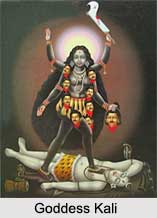 Goddess Kali is the Hindu Goddess associated with eternal energy, violence, death, sexuality and ironically with maternal love. In the series of the Ten Mahavidyas, Kali comes first, as she represents the power of consciousness in its highest form. She is worshipped as the ultimate reality. Goddess Kali is represented as the wife of Lord Shiva. She is also known as "Kalikamata" (black earth-mother) and "Kalaratri" (black night). She is often regarded as Shiva"s Shakti and is associated with him in various Indian Puranas. In Kalika Purana, she is depicted as the "Adi Shakti" and "Para Prakriti".
Goddess Kali is the Hindu Goddess associated with eternal energy, violence, death, sexuality and ironically with maternal love. In the series of the Ten Mahavidyas, Kali comes first, as she represents the power of consciousness in its highest form. She is worshipped as the ultimate reality. Goddess Kali is represented as the wife of Lord Shiva. She is also known as "Kalikamata" (black earth-mother) and "Kalaratri" (black night). She is often regarded as Shiva"s Shakti and is associated with him in various Indian Puranas. In Kalika Purana, she is depicted as the "Adi Shakti" and "Para Prakriti".
Origin of Goddess Kali
Goddess Durga as "Ambika", battling the Asura army was confronted by a pair of Asura generals named Chanda and Munda. Kali emerged from Ambika"s forehead, armed with a sword and noose, bearing the strange skull-topped staff, decorated with a garland of skulls and clad in a tiger"s skin, with gaping mouth assuming a fearful form. Kali has emerged as the personified wrath of the Divine Mother Durga. With her tongue out and deep-sunk reddish eyes she filled the regions of the sky with her roars and falls upon the asuras slaughtering their army. She defeats Chanda and Munda and brings Ambika their heads for which she is known as "Chamunda".
In Upanishads, Kali is the name of one of the seven tongues of Lord Agni, the God of Fire. She had appeared in the 6th century as "Devi Mahatmyam", one of the Shaktis of Devi and slays Asura Raktabija.
 Iconography of Goddess Kali
Iconography of Goddess Kali
Goddess Kali is portrayed in 4 armed form and in 10 armed Mahakali aspect also. In the 10 armed form of Mahakali she has 10 faces and 10 feet and 3 eyes. Her most common image shows her each hand carrying a sword, a trident, a severed head and a skull-cup catching the blood of the severed head.
The appearance of Goddess Kali is fearsome with baleful eyes, a protruding tongue and 4 arms. In her upper left hand she wields a bloody sword and in her lower left hand she holds the severed head of a demon. With her upper right hand she makes the gesture of fearlessness, while the lower right hand confers benefits. Draped around her is a chain of severed human heads and she wears a belt made of dismembered arms. As the Divine Mother she is often represented standing or dancing on Shiva.
Forms of Goddess Kali
There are several forms of Goddess Kali that are popularly worshiped. Every avatar of Goddess Kali has some significance.
•Goddess Kali: Slayer of the demons Chanda and Munda.
•Goddess Matangi: Violent reincarnation of the Goddess of Knowledge, Saraswati.
•Goddess Chhinnamasta: Symbolizes Death and Creation together.
•Goddess Shamsana Kali: Presides over the affairs of the crematorium.
•Goddess Bagala: Violent avatar of Kali.
•Goddess Bhairavi: Harbinger of death.
•Goddess Tara: Kali in her light blue colour. Often shown naked to the waist and clad in tiger skin.
•Goddess Shodasi: Portrayed as the seductress.
•Goddess Kamala: A tantric form of the Goddess of wealth and prosperity, Lakshmi.
•Goddess Dhumavati: Represented as an antithesis of Lakshmi.
•Goddess Dakat Kali: Goddess of dacoits.
•Goddess Bhadrakali: Protector of the good.
Worship of Goddess Kali
Goddess Kali is worshipped particularly in West Bengal. Her best-known temples are in Kalighat and Dakshineshwar. Worshipping of Goddess Kali takes away the darkness from everyone who strives for perfection by performing the spiritual disciplines of purifying austerities. Kali worship is performed daily at the Devi Mandir as part of the Cosmic Puja. A grand Kali Puja festival is held on the new moon night of the month of Ashwin (October-November).









